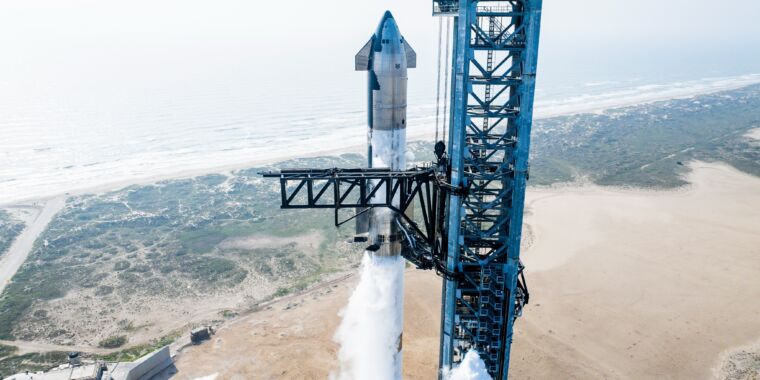SpaceX
SpaceX is targeting June 5 for the next flight of its massive Starship rocket, the company said Friday.
The highly anticipated test flight – the fourth in a program to make Starship operationally ready and make progress toward its eventual reuse – will attempt to demonstrate the Super Heavy first stage’s ability to make a soft landing in the Gulf of Mexico and for the spacecraft’s Upper Stage to make a controlled reentry through Earth’s atmosphere before falling into the Indian Ocean.
This mission will not carry payload as SpaceX seeks additional flight data on the performance of the complex Starship vehicle. It is at the same time the largest and most powerful rocket ever built and the first launch system ever intended to be completely and quickly reusable.
As part of the flight date announcement, SpaceX provided some information about the findings of its most recent flight test, Flight 3, which launched on March 14, 2024.
Dissection flight 3
During that flight, SpaceX also attempted a soft landing of the Super Heavy first stage. Following the separation of the Starship’s upper stage as intended, 13 of Super Heavy’s 33 Raptor engines successfully reignited to make a controlled flight through the lower atmosphere. However, during this boostback burn, six of these engines were shut down prematurely. Later in the descent, as the rocket approached the sea surface, the rocket had to use the same 13 engines to make a final landing.
“The six engines that were shut down early in the boostback burn were unable to attempt the landing again, resulting in seven engines being ordered to start up, while two successfully reached the main stage ignition,” the company said in its summary of the flight. “The booster had a lower than expected landing force when contact was lost approximately 1,500 feet (462 meters) above the Gulf of Mexico and just under seven minutes into the mission.”
The cause of this failure was traced to a blockage in a filter where liquid oxygen flows into the Raptor engines. A similar issue notably occurred during Starship’s second test flight in November 2023. SpaceX says it has made “hardware changes” to address this stalling issue for the third test flight. Now the company said, “Super Heavy boosters for Flight 4 and beyond will receive additional hardware in oxygen tanks to further improve propellant filtration capabilities.” It will be interesting to see if the company’s engineers have successfully addressed this issue.
As for the spacecraft’s upper stage, the vehicle began to lose the ability to control its attitude during the coasting phase in space. This turned out to be due to clogged valves used by reaction control thrusters on the upper stage. The company’s update notes that “SpaceX has since added additional roll control thrusters to upcoming spacecraft.” But it’s not clear that they will be available for Flight 4. In fact, the fact that SpaceX is not An attempt to reignite Raptor engines in flight on the Starship’s upper stage suggests that these new roll control thrusters are not yet in place.
Ultimately, this lack of attitude control during Flight 3 resulted in a non-nominal reentry into the Earth’s atmosphere. SpaceX was able to maintain contact with the vehicle up to an altitude of 40 miles before losing telemetry due to excessive heating.
Back to basic
During Flight 3, SpaceX achieved a number of major milestones, including the opening of the spaceship door in space and a small demonstration of propellant transfer. However, due to the loss of attitude control, a planned Raptor rocket engine re-ignition test was not conducted. This is an important test, because the Raptor ignition is needed to perform a controlled reentry – essentially ensuring that the Starship returns to a remote part of the ocean rather than land.
For the next flight, SpaceX is focusing on resolving the technical issues observed during Flight 3: the filter blockages observed during Super Heavy’s boostback and landing burns, controlling the Starship’s attitude during the coast phase, and managing of that vehicle’s return from orbit.
Once these issues are resolved, the company can move on to more advanced testing, including landing the Super Heavy booster at the South Texas launch site, deploying Starlink satellites, and additional propellant transfer tests essential to NASA’s Artemis program to land people on the ground. Moon.
